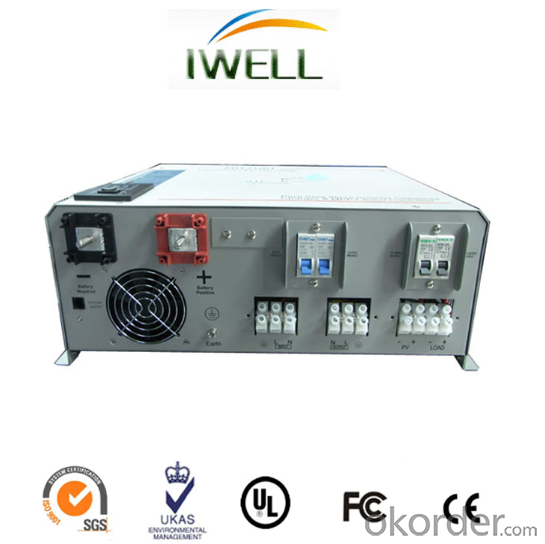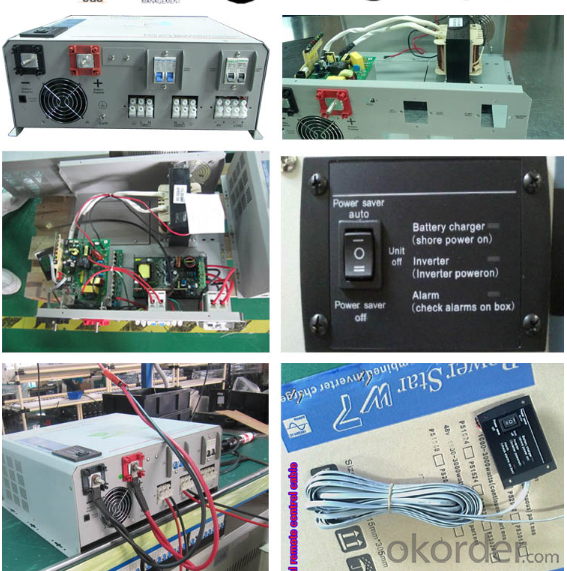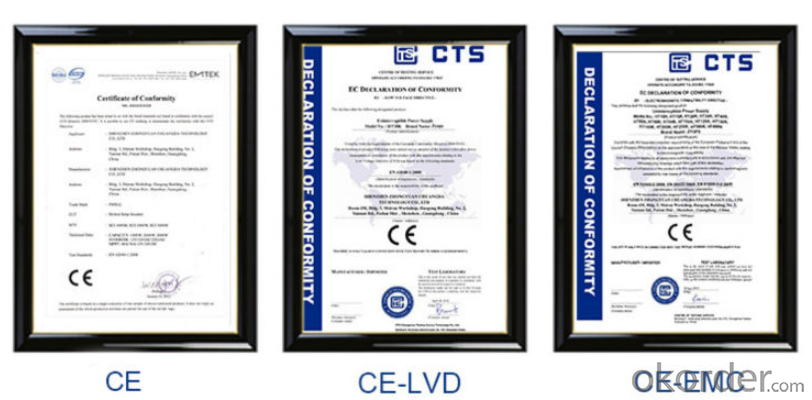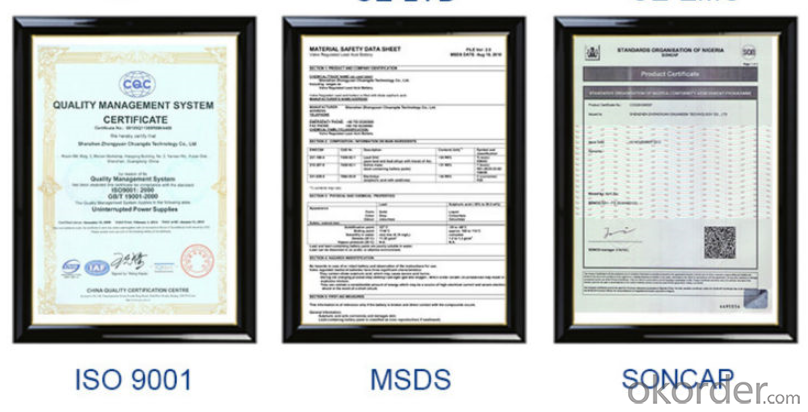Solar System 12V 24V 1-3KW Inverter with Controller and Charger Pure Sine Wave
- Loading Port:
- Qingdao
- Payment Terms:
- TT or LC
- Min Order Qty:
- 50 unit
- Supply Capability:
- 3000 unit/month
OKorder Service Pledge
OKorder Financial Service
You Might Also Like
1. Structure of Solar System 12V 24V 1-3KW Inverter with Controller and Charger Pure Sine Wave
A solar inverter, or PV inverter, or Solar converter, converts the variable direct current (DC) output of a photovoltaic (PV) solar panel into a utility frequency alternating current (AC) that can be fed into a commercial electrical grid or used by a local, off-grid electrical network.
It is a critical BOS–component in a photovoltaic system, allowing the use of ordinary AC-powered equipment.
Solar inverters have special functions adapted for use with photovoltaic arrays, including maximum power point tracking and anti-islanding protection.
2. Main Features of the Solar System 12V 24V 1-3KW Inverter with Controller and Charger Pure Sine Wave
﹒Output waveform: pure sine wave
﹒High efficiency>85%
﹒12v or24v or 48vDC input
﹒AC100V or AC110V or AC120V/220v /230V /240V AC output
﹒Output frequency 60HZ or 50HZ
﹒Continuous output power:10KW
﹒High-velocity cooling fan
﹒Overload protect ,over voltage protect ,low voltage cut-out ,low voltage alarm
3. Solar System 12V 24V 1-3KW Inverter with Controller and Charger Pure Sine Wave Images





4. Solar System 12V 24V 1-3KW Inverter with Controller and Charger Pure Sine Wave Specification
Mode | PTV 500W | PTV 1000W | PTV 1500W | PTV 2000 | PTV 3000 |
Continuous power (W) | 500W | 1000W | 1500W | 2000W | 3000W |
Surge capability (W) | 1500W | 3000W | 4500W | 6000W | 6000W |
System DC input (VDC) | 12VDC | 24VDCV | 24VDC | 24VDC | 24VDC |
AC Output | 110 / 120V/ 220V/230V ±5% , 50HZ or 60HZ. Terminal | ||||
AC Output waveform | Pure Sine Wave | ||||
DC output | 12VDC or 24VDC Terminal | ||||
Efficiency | 88% | ||||
AC/DC Charger | Max 15A | Max 25A | Max 25A | Max 40AMP | Max 50 |
Solar Charge Controller | MPPT,20AMP | MPPT,30AMP | MPPT,40AMP | MPPT,50AMP | MPPT 100AMP |
Adviced PV | 36 or 72 Cell | 72 Cell | 72 Cell | 72 Cell | 72 Cell |
External battery back | 12 or 24VDC | 24VDC | 24VDC | 24VDC | 24VDC |
Breakers | with Breakers for AC Input , AC output, PV input , DC output | ||||
Battery low protection | yes | ||||
Over discharge protection | yes | ||||
Resume voltage | yes. When fault remove | ||||
Over voltage protection | yes | ||||
Overload protection | yes. | ||||
With cooling fan | yes | ||||
Display | LED for Inverter,charger,Battery Capacity state, DC load state and fault. LCD display is optional | ||||
Running Temperature | -35 degree to 55 degree | ||||
High temperature protection | YES | ||||
Short circuit protection | YES | ||||
Reverse polarity protection | YES. Only for DC load side. | ||||
Stand by | yes. continou ouput while > 25W | ||||
Communication | RS232 Power Manager, NetAgent SNMP , Optional for LED mode | ||||
Package Size(mm) | 608*558*293 | 608*558*293 | 608*558*293 | 608*558*293 | 608*558*293 |
Gross Weight KG | 21 | 24 | 24 | 26 | 32 |
product Size (mm) | 460*440*200 | 460*440*200 | 460*440*200 | 460*440*200 | 460*440*200 |
product weight( kg) | 15KG | 16KG | 16KG | 19.5KG | 24KG |
5. FAQ of Solar System 12V 24V 1-3KW Inverter with Controller and Charger Pure Sine Wave
Q1. What is the difference between inverter and solar inverter?
A1. Inverter only has AC inpput, but solar inverter both connect to AC input and solar panel, it saves more power.
Q2. What is the difference between MPPT&PWM?
A2. MPPT has higher efficiency, it can track the max power point and won't waste energy.
Q3. What is the waranty of product?
A3. 12 months.
- Q:How do you calculate the efficiency of a solar inverter?
- To calculate the efficiency of a solar inverter, you need to divide the output power by the input power and multiply the result by 100 to get a percentage. The formula is: Efficiency = (Output Power / Input Power) * 100.
- Q:Can a solar inverter be connected to a home automation system?
- Yes, a solar inverter can be connected to a home automation system. This integration allows for better control and monitoring of the solar energy production and enables homeowners to optimize their energy usage based on real-time data.
- Q:Can a solar inverter be used in standalone systems?
- Yes, a solar inverter can be used in standalone systems. Standalone systems, also known as off-grid systems, are not connected to the electrical grid and rely on alternative sources of power such as solar panels. Solar inverters are crucial in standalone systems as they convert the direct current (DC) produced by the solar panels into alternating current (AC) that is used to power household or commercial appliances.
- Q:Can a solar inverter be used for both single-phase and three-phase applications?
- No, a solar inverter cannot be used for both single-phase and three-phase applications. Different types of inverters are designed specifically for either single-phase or three-phase systems, as they have different voltage and power requirements.
- Q:What is the role of a solar inverter in preventing system failures?
- The role of a solar inverter in preventing system failures is to convert the direct current (DC) produced by solar panels into alternating current (AC) that can be used by household appliances and sent back to the electrical grid. By ensuring that the DC power generated by the solar panels is properly converted and synchronized with the grid, the inverter helps maintain the stability and reliability of the entire solar power system. Additionally, the inverter monitors the voltage, frequency, and overall performance of the system, allowing it to detect and respond to any potential issues or faults that could lead to system failures.
- Q:How does a solar inverter handle variations in solar panel cleanliness?
- A solar inverter is not directly responsible for handling variations in solar panel cleanliness. However, a clean solar panel allows for maximum absorption of sunlight, resulting in optimal energy production. If solar panels are dirty, the amount of sunlight absorbed decreases, leading to reduced energy generation. It is the responsibility of the solar panel owner to regularly clean and maintain the panels to ensure their efficiency.
- Q:How does a solar inverter handle power factor optimization?
- A solar inverter handles power factor optimization by continuously monitoring the power factor of the AC output and adjusting its operation accordingly. It employs various techniques such as reactive power compensation, voltage regulation, and harmonic suppression to ensure that the power factor remains close to unity, maximizing the efficiency of the solar system.
- Q:Can a solar inverter be used in standalone power systems?
- Yes, a solar inverter can be used in standalone power systems. Standalone power systems, also known as off-grid systems, are not connected to the traditional electrical grid. In such systems, solar inverters convert the direct current (DC) generated by solar panels into alternating current (AC) that can be used to power various electrical devices and appliances. The solar inverter is an essential component in standalone power systems as it enables the efficient utilization of solar energy for off-grid applications.
- Q:Can a solar inverter be used in conjunction with a battery management system?
- Yes, a solar inverter can be used in conjunction with a battery management system. The battery management system is responsible for monitoring and controlling the battery's charging and discharging processes, while the solar inverter converts the direct current (DC) generated by solar panels into alternating current (AC) to power household appliances. By integrating these two systems, solar energy can be efficiently stored and utilized when needed.
- Q:What is the importance of surge protection in a solar inverter?
- There are several reasons why surge protection is extremely important in a solar inverter. Firstly, solar inverters have the responsibility of converting the direct current (DC) generated by solar panels into alternating current (AC) that can be used to power electrical devices. This conversion process can potentially cause power surges or voltage spikes. If these surges occur, they can harm the sensitive electronic components inside the inverter, resulting in malfunctions or even complete failure. Secondly, solar inverters are often connected to the electrical grid, which allows excess electricity produced by the solar panels to be sent back into the grid. However, the grid is susceptible to power fluctuations and surges caused by lightning strikes, utility switching, or other external factors. Without sufficient surge protection, these power surges can travel back through the grid and cause damage to the solar inverter. Furthermore, surge protection is crucial for safeguarding the entire solar power system. Apart from the solar inverter, there are other interconnected components like charge controllers, battery systems, and monitoring equipment. Any surge occurring in any part of the system has the potential to damage or disrupt the operation of the entire system. By incorporating surge protection devices like surge suppressors or surge arresters into the solar inverter, excess energy from power surges is diverted away from the sensitive electronic components. These devices are specifically designed to absorb or redirect the surge, thereby shielding the inverter and other connected equipment. In conclusion, surge protection is of utmost importance in a solar inverter as it prevents damage from power surges during the conversion process, provides protection against external power fluctuations from the grid, and safeguards the entire solar power system. Investing in proper surge protection ensures the long-lasting and reliable functioning of the solar inverter, minimizing the risk of expensive repairs or replacements.
1. Manufacturer Overview |
|
|---|---|
| Location | |
| Year Established | |
| Annual Output Value | |
| Main Markets | |
| Company Certifications | |
2. Manufacturer Certificates |
|
|---|---|
| a) Certification Name | |
| Range | |
| Reference | |
| Validity Period | |
3. Manufacturer Capability |
|
|---|---|
| a)Trade Capacity | |
| Nearest Port | |
| Export Percentage | |
| No.of Employees in Trade Department | |
| Language Spoken: | |
| b)Factory Information | |
| Factory Size: | |
| No. of Production Lines | |
| Contract Manufacturing | |
| Product Price Range | |
Send your message to us
Solar System 12V 24V 1-3KW Inverter with Controller and Charger Pure Sine Wave
- Loading Port:
- Qingdao
- Payment Terms:
- TT or LC
- Min Order Qty:
- 50 unit
- Supply Capability:
- 3000 unit/month
OKorder Service Pledge
OKorder Financial Service
Similar products
New products
Hot products
Hot Searches
Related keywords































